A few years ago, enterprises began adopting chatbots to streamline routine customer interactions, reduce operational burdens, and provide consistent, immediate responses. These tools were an early step in enterprise AI automation, helping teams handle repetitive queries while freeing them for higher-value work.
However, as businesses scaled and customer expectations increased, the limitations of rule-based chatbots became apparent. Multi-step workflows, nuanced inquiries, and cross-department coordination often exceeded their capabilities, leaving teams to compensate manually and customers facing friction, delays, and inconsistent experiences.
So, how can automation evolve to meet the growing complexity of enterprise operations? The answer lies in AI agents, the next generation of intelligent automation. Unlike rule-based chatbots, AI agents are context-aware, autonomous collaborators.
They synthesize signals across systems, reason through ambiguity, and take smart actions across workflows from delivering personalized customer experiences to optimizing internal operations. By transforming automation into a strategic lever, AI agents drive efficiency, actionable insights, and measurable impact, enabling enterprises to act decisively in real time.
The evolution from chatbots to AI agents is a strategic move for enterprises seeking real results from digital transformation. This blog demystifies why they’re often misunderstood, explains how they work, their various types, and key differences, highlights the value they create, addresses common pitfalls, and guides you in choosing the right solution to drive growth, efficiency, and a superior customer experience.
Why chatbots and AI agents are often confused
Enterprises often struggle to distinguish between chatbots and AI agents because they share foundational technologies, such as artificial intelligence (AI), natural language processing (NLP), and conversational AI interfaces, and both interact with users through conversations that appear human-like. At first glance, they appear similar, but their capabilities, complexity, and business impact differ significantly.
Consider a customer query that spans multiple departments, such as a request for account updates, technical troubleshooting, and personalized recommendations. A rule-based chatbot can answer repetitive, predefined questions and guide the user through structured steps. But when the inquiry requires context awareness, reasoning across systems, and multi-step workflows, a human agent or AI agent must intervene. Here lies the source of confusion: both solutions seem to operate in the same space, yet their intelligence and autonomy vary dramatically.
Several factors contribute to this confusion:
- Shared interface experience: Both rely on conversational AI, which masks the underlying technical sophistication, making them seem interchangeable.
- Overlapping terminology and branding: Vendors frequently label both as AI-powered systems, blurring distinctions for business leaders.
- Surface-level use case similarity: Common applications, such as customer support, information retrieval, and basic automation, can be served by either solution.
- Marketing language: Providers may overstate the intelligence of chatbots or understate the complexity of agents, leaving decision-makers uncertain.
- Limited technical visibility: Executives without deep AI expertise may struggle to evaluate autonomous decision-making, multi-step workflows, and contextual reasoning.
- Feature integration in modern platforms: Many platforms combine the simplicity of chatbots with the sophistication of AI agents, further complicating classification.
- End-user perception: Users judge tools by ease of conversation and responsiveness, not by the AI’s underlying complexity.
- Ubiquity of AI capabilities: With generative AI now embedded across enterprise tools, distinctions blur unless there is a clear strategy for where intelligent agents fit.
For enterprises, understanding these differences is crucial. Chatbots remain effective for routine, predictable tasks, handling repetitive inquiries and predefined processes efficiently. In contrast, AI agents excel in dynamic, complex scenarios, leveraging context awareness, real-time data, and autonomous decision-making to deliver personalized experiences, optimize internal operations, and drive operational efficiency with minimal human intervention.
By distinguishing chatbots from AI agents, organizations can make informed investments in AI-powered systems, improving customer experience, streamlining workflows, and accelerating digital transformation, turning automation into a strategic lever rather than a tactical tool.
What chatbots are, how they work, and the types that exist
Chatbots are rule-based conversational AI tools designed for speed, consistency, and efficiency. While they are widely adopted in enterprises, not all chatbots are created equal. Understanding their types, logic, and limitations is crucial for using them strategically, whether for customer interactions, operational efficiency, or automating routine tasks.
What is a chatbot
A chatbot is a conversational interface that simulates human-like interactions by processing and responding to user inputs, primarily in natural language. Unlike AI agents, chatbots do not reason autonomously or perform complex workflows. Their primary role is to provide immediate, automated responses within a limited context, handling repetitive tasks, predefined queries, or transactional requests without human intervention.
In enterprise settings, chatbots act as front-line digital assistants, streamlining customer support, information retrieval, and internal guidance. They operate best in structured scenarios but are constrained when faced with dynamic or multi-step processes that require contextual understanding, integration with external tools, or real-time data analysis.
How chatbots work
Chatbots operate through a combination of intent detection and natural language understanding (NLU) to identify user needs and extract relevant information, scripted dialogue flows and predefined responses that guide users through structured interactions, and response generation mechanisms that select the most appropriate answer from a fixed set or knowledge base.
Most chatbots are stateless, meaning they do not retain memory of past interactions, which limits their ability to manage multi-turn conversations or complex workflows. Furthermore, legacy chatbots often have limited integration with external systems or APIs, which constrains their ability to perform autonomous tasks or access real-time data.
Types of chatbots
Enterprises deploy different types of chatbots depending on use cases, integration requirements, and desired conversational sophistication. The main categories include:

- Rule-based chatbots: Operate on predefined if-then rules and decision trees. They excel at handling straightforward, repetitive tasks, such as answering FAQs or guiding users through predefined workflows, but cannot understand nuance or context beyond their scripts.
- Retrieval-augmented chatbots: Combine rule-based logic with access to structured knowledge bases or document repositories. They dynamically retrieve relevant information but remain dependent on existing data, lacking true generative capabilities.
- LLM-powered chatbots: Leverage large language models (LLMs) to generate more fluid, context-aware responses, improving user interactions and conversational flexibility. While they provide a richer experience, unpredictability, domain specificity challenges, and the need for governance must be managed carefully in enterprise contexts.
Each type presents distinct advantages and limitations. Choosing the right model depends on striking the desired balance between control, scalability, operational efficiency, and conversational sophistication, all of which are aligned with organizational objectives.
What AI agents are, how they work, and the types that exist
In modern customer support, AI agents go far beyond scripted replies. They interpret intent, adapt to context, and take action across systems, reshaping how businesses resolve issues at scale.
What is an AI agent
An AI agent is an autonomous AI system capable of observing its environment, reasoning through ambiguity, and performing tasks independently. These systems integrate AI technology, machine learning, and real-time data to deliver goal-driven actions, often across multiple workflows.
In customer support and enterprise operations, AI agents go beyond scripted interactions to provide more personalized support. They understand nuanced customer intent, orchestrate multi-step resolutions, and interact with backend systems and external tools to provide contextually relevant guidance. Their autonomy reduces human intervention, enhances operational efficiency, and drives measurable improvements in customer satisfaction.
Modern AI agents often leverage frameworks and tools like OpenAI, Anthropic, or LangChain, which enable agentic AI architectures for enterprise-scale applications, supporting complex workflows, memory retention, and multi-turn interactions.
How AI agents work
AI agents function through a continuous Observe → Plan → Act → Learn cycle that mirrors intelligent human behavior. They begin by observing collecting data from customer queries, enterprise systems, external APIs, and real-time data streams. Next, they plan by applying advanced algorithms, predictive modeling, and context-aware reasoning to evaluate possible actions aligned with business objectives. In the act phase, agents autonomously execute tasks such as responding to customers, triggering workflows, updating records, or invoking external tools.
Finally, they learn from every interaction, refining their models, improving reasoning, and enhancing contextual understanding for future performance. Equipped with persistent memory systems, AI agents can retain contextual knowledge, enabling multi-step, multi-turn conversations that feel fluid and adaptive.
Their seamless integration with enterprise systems and external platforms allows them to autonomously perform complex tasks, from resolving customer issues to recommending next-best actions in real time, transforming customer support into a more intelligent, proactive, and continuously improving function.
Types of AI agents
Enterprise AI agents can be categorized based on their intelligence, adaptability, and decision-making sophistication:
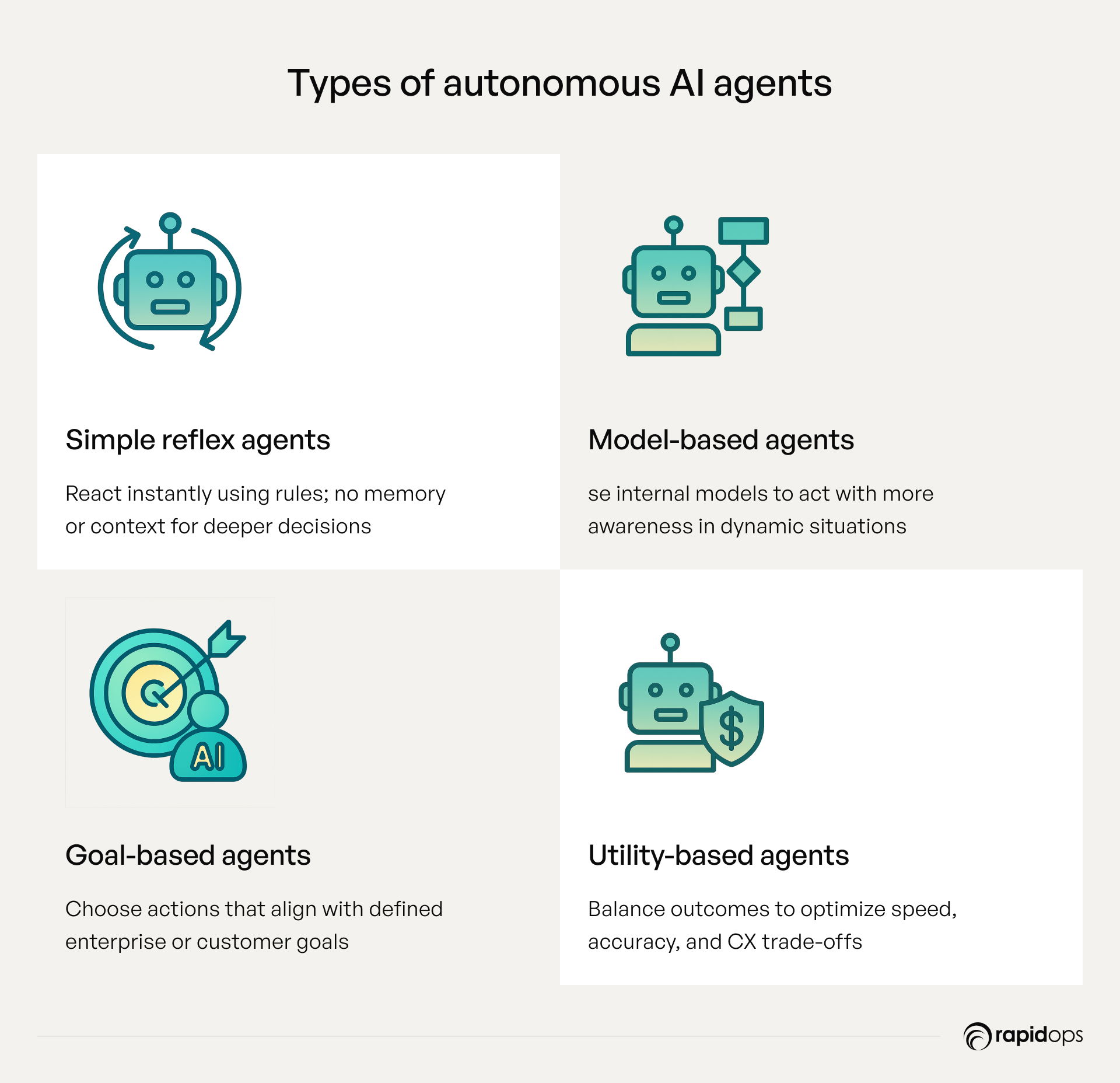
- Simple reflex agents: Operate on immediate inputs with predefined rules, reacting to stimuli without internal state or memory. In customer support, these may handle basic triggers but lack contextual depth.
- Model-based reflex agents: Maintain an internal representation of the environment, allowing context-aware decisions in partially observable situations.
- Goal-based agents: Make decisions aimed at achieving specific objectives. They evaluate potential future states and select actions that advance toward defined customer service goals, such as resolving issues or enhancing customer satisfaction.
- Utility-based agents: Incorporate preferences and trade-offs by assigning utilities to different outcomes. These agents optimize their behavior to maximize overall value, balancing factors such as speed, accuracy, and the quality of customer experience.
Each type of AI agent offers a distinct level of intelligence, tailored to the complexity of customer support scenarios, ranging from handling routine inquiries to resolving multi-step issues across various systems. Choosing the right model is a strategic step toward building responsive, scalable support capabilities that align with service goals and customer expectations.
However, real impact comes not just from model selection, but from thoughtful development blending orchestration, backend integration, and domain-specific knowledge. By collaborating with experts in, enterprises can ensure their customer support solutions are context-aware, adaptable, and built to drive lasting improvements in service efficiency and satisfaction.
AI agent vs chatbot: Key differences that matter
For enterprises transforming customer support, understanding the fundamental differences between AI agents and chatbots is critical to selecting the right technology that delivers measurable impact. Both leverage AI technology and natural language processing, but their design, capabilities, and strategic value vary significantly.
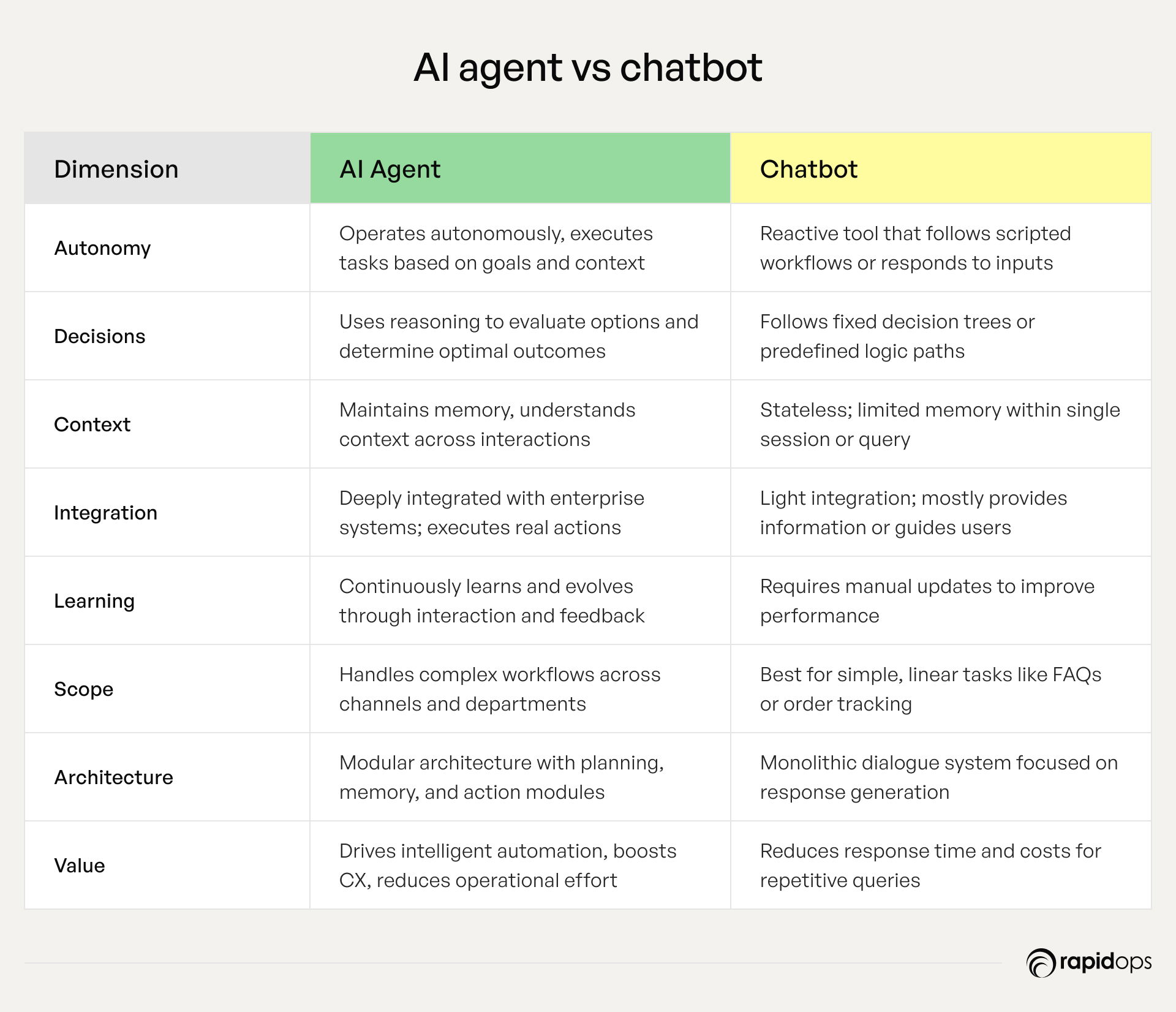
Autonomy vs. reactivity
AI agents operate autonomously, continuously observing customer interactions and enterprise systems, reasoning about goals, and executing multi-step workflows in dynamic environments. For example, an AI agent may identify recurring billing issues and trigger remediation across multiple platforms without human intervention, ensuring minimal delays and improved operational efficiency.
Chatbots, in contrast, are reactive, relying on predefined rules or scripted dialogues. They handle routine tasks, such as answering FAQs or tracking order status, but cannot independently act or adapt to evolving scenarios.
Autonomous intelligence and strategic reasoning
AI agents excel in autonomous intelligence, analyzing multiple possible outcomes to optimize customer experience and operational efficiency. Their use of advanced algorithms allows them to reason through ambiguity, handle complex interactions, and deliver contextually relevant solutions across departments.
Chatbots are limited to static decision trees or pattern matching, lacking reasoning capabilities that restrict them to predefined responses and simpler workflows.
Context awareness and memory
AI agents maintain past interactions, creating context aware conversations across multiple sessions and channels. This continuity enables them to deliver highly personalized experiences, such as recalling customer preferences or previous complaints to optimize resolutions.
Chatbots operate mostly statelessly, confined to isolated sessions, which limits their ability to provide continuous support or manage complex workflows effectively.
Tool integration and action execution
AI agents seamlessly integrate with external tools, including CRM systems, ticketing platforms, and knowledge bases, enabling them to perform real-world tasks autonomously updating customer records, triggering refunds, or escalating issues. This integration makes them powerful AI-powered systems capable of driving AI-driven automation.
Chatbots have limited tool integration and primarily serve as information retrieval or guided support tools, restricting their operational scope.
Learning, adaptation, and AI assistant capabilities
AI agents continuously learn from interactions, refining machine learning models to adapt to emerging scenarios, such as unstructured data or new product issues. Their capabilities extend beyond standard support, functioning like AI assistants that can orchestrate tasks across multi-agent systems for enhanced coordination and efficiency.
Chatbots require manual updates or retraining, which slows their response to changing conditions and limits adaptability in real-time data scenarios.
System architecture
AI agents are built on modular, multi-component architectures that combine planners, memory stores, and action executors. They utilize large language models and advanced algorithms to efficiently manage complex workflows and multi-step tasks.
Chatbots typically rely on monolithic dialogue frameworks, which focus on scripted responses and lack the flexibility to handle evolving enterprise demands or orchestrate dynamic environments.
By understanding these distinctions, enterprises can deploy AI agents to elevate customer interactions, optimize operational efficiency, and achieve scalable, intelligent automation. Chatbots remain valuable for straightforward tasks, but AI agents unlock advanced capabilities, including context-aware reasoning, multi-step workflow management, and enterprise-wide AI assistant functionality.
How chatbots and AI agents drive value for your enterprise
Enterprises leveraging AI technology can strategically deploy chatbots and AI agents to optimize customer support efficiency, streamline operations, and enhance the overall customer experience. While both tools contribute to value creation, their roles are distinct. Chatbots simplify routine interactions, whereas AI agents provide adaptive intelligence for complex workflows and multi-step processes.
Chatbot value: Simplify routine tasks
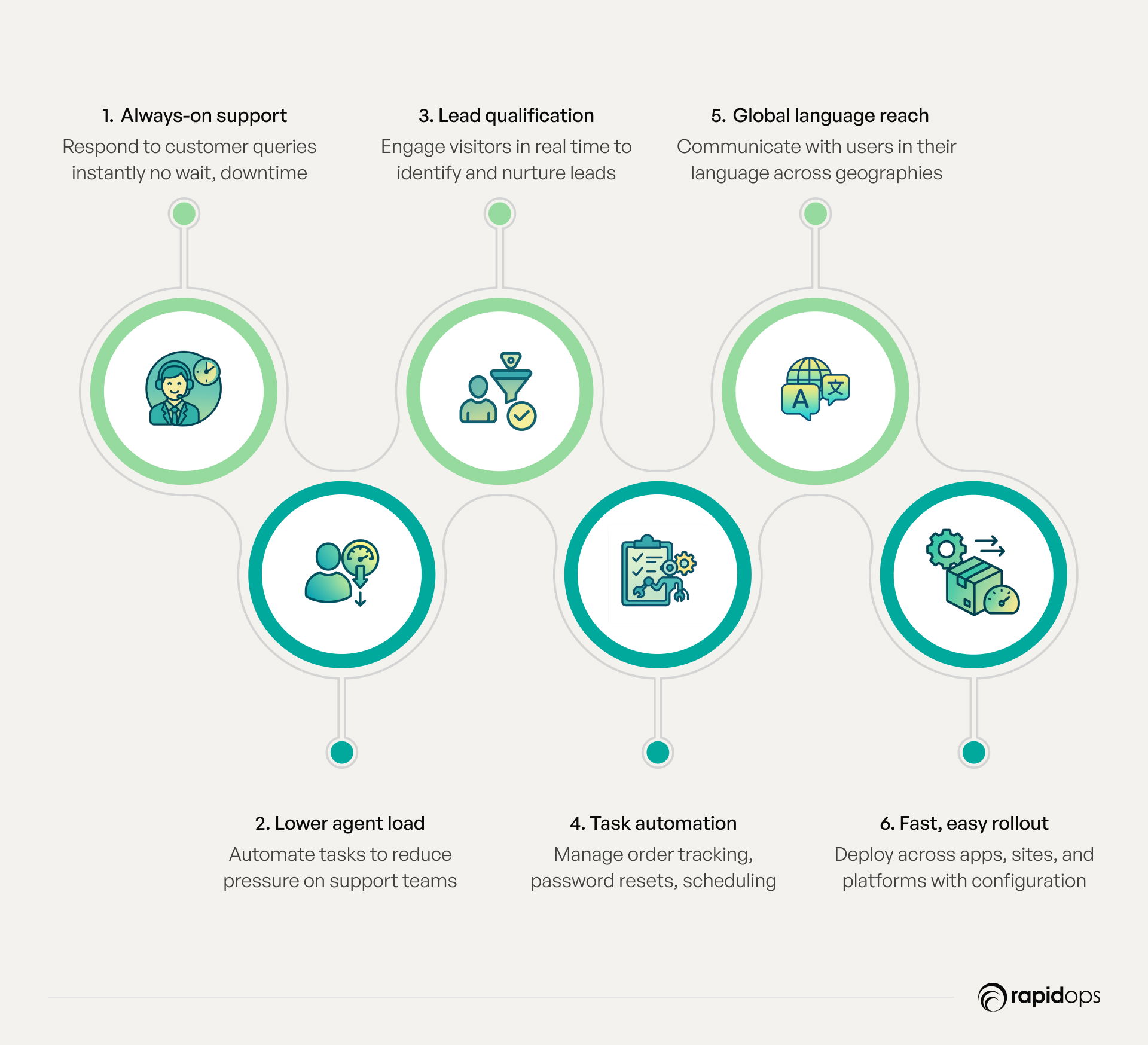
Chatbots serve as virtual assistants that handle repetitive customer inquiries, enabling enterprises to reduce reliance on human agents and minimize human intervention. Using natural language processing, they efficiently manage routine tasks such as password resets, order tracking, appointment scheduling, and answering FAQs.
Beyond basic support, chatbots capture and qualify sales leads, engaging visitors in real time to transform casual user interactions into measurable business opportunities. Their multi-language capabilities and seamless deployment across multiple channels ensure consistent, context-aware conversations while broadening reach to diverse customer bases.
With minimal configuration and rapid deployment, chatbots offer 24/7 availability, providing instant, standardized responses. This enhances customer experience, reduces operational load, and frees human efforts for higher-value tasks. AI-powered chatbots further extend efficiency by automating predefined processes without ongoing maintenance.
AI agent value: Automate complex workflows
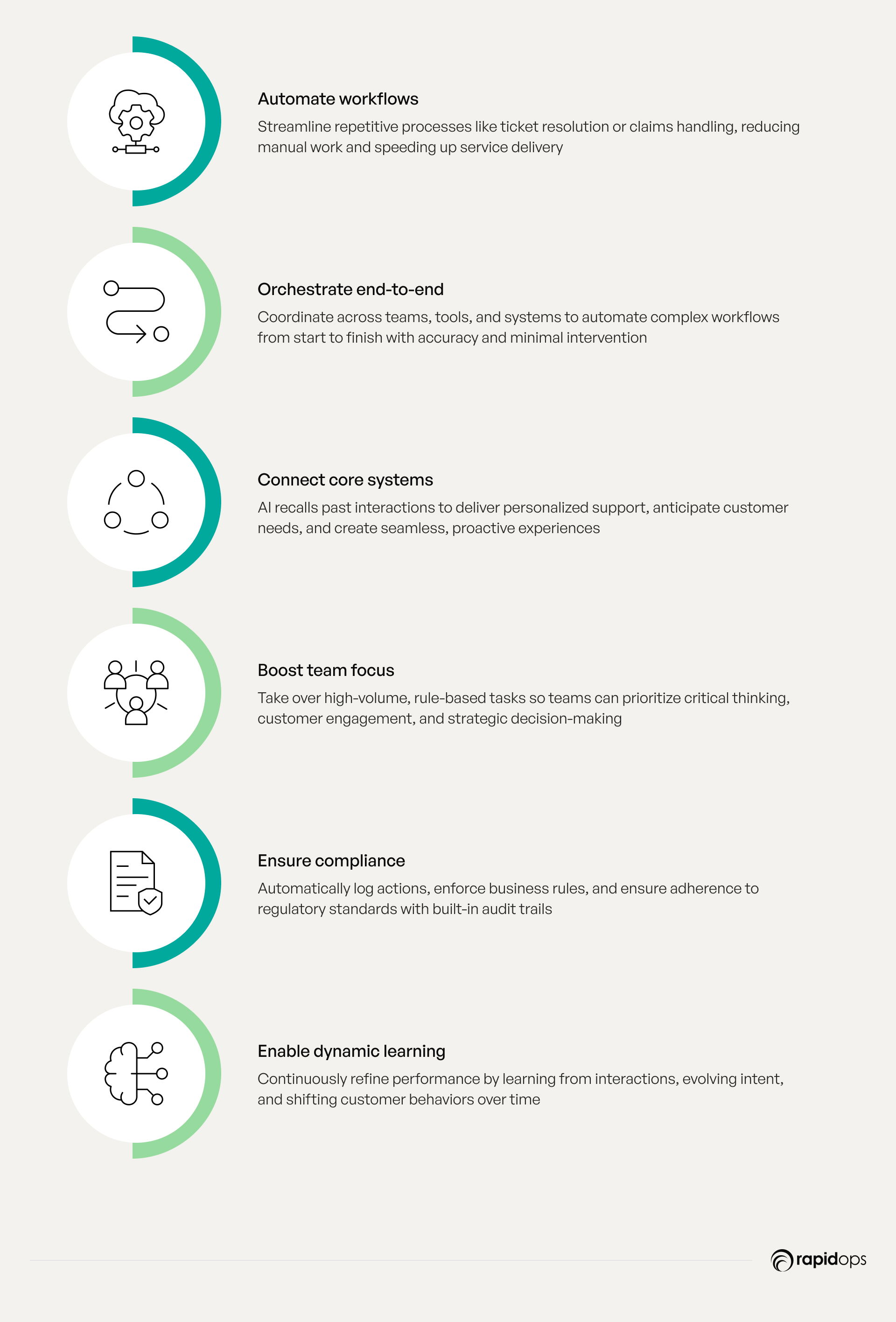
AI agents elevate customer support by automating complex interactions that go far beyond reactive support. These autonomous AI systems observe customer queries, enterprise systems, and historical interactions to orchestrate multi-step workflows with minimal human intervention.
By integrating with external tools, CRMs, ERPs, ticketing systems, and knowledge bases, AI agents coordinate actions across departments, reducing data silos and enabling seamless resolution of intricate customer issues. Their ability to retain memory of past interactions allows for context-aware conversations, personalizing responses based on prior complaints, preferences, or recurring problems.
Generative AI and large language models power AI agents to dynamically adapt to evolving customer needs, user inputs, and enterprise signals. They can execute sophisticated tasks such as escalating tickets, updating customer records, matching invoices, or handling claims processing autonomously. This reduces the burden on support teams, enabling them to focus on strategic initiatives.
AI agents also provide transparency and compliance by maintaining audit trails and enforcing operational protocols consistently. Continuous learning ensures AI agents evolve alongside customer support requirements, sustaining long-term value and improving operational efficiency. By automating more complex tasks and coordinating multiple tasks across systems, AI agents transform customer support from transactional interactions to a proactive, intelligence-driven function.
By deploying chatbots for routine inquiries and AI agents for complex workflows, enterprises achieve a balanced approach to AI-driven automation. Chatbots ensure immediate efficiency and consistent customer engagement, while AI agents provide adaptive, scalable solutions that optimize support processes, enhance customer experience, and deliver sustained operational value.
This combined strategy allows enterprises to harness AI technology advances effectively, ensuring long-term resilience, agility, and business growth.
100 proven AI agent use cases delivering immediate impact, without the need for massive technology overhauls!
Download Now
Pitfalls to be aware of: It’s not one-size-fits-all
Not every solution fits every enterprise. Understanding unique challenges and aligning technology choices with your specific needs is crucial to avoid costly missteps and maximize impact.
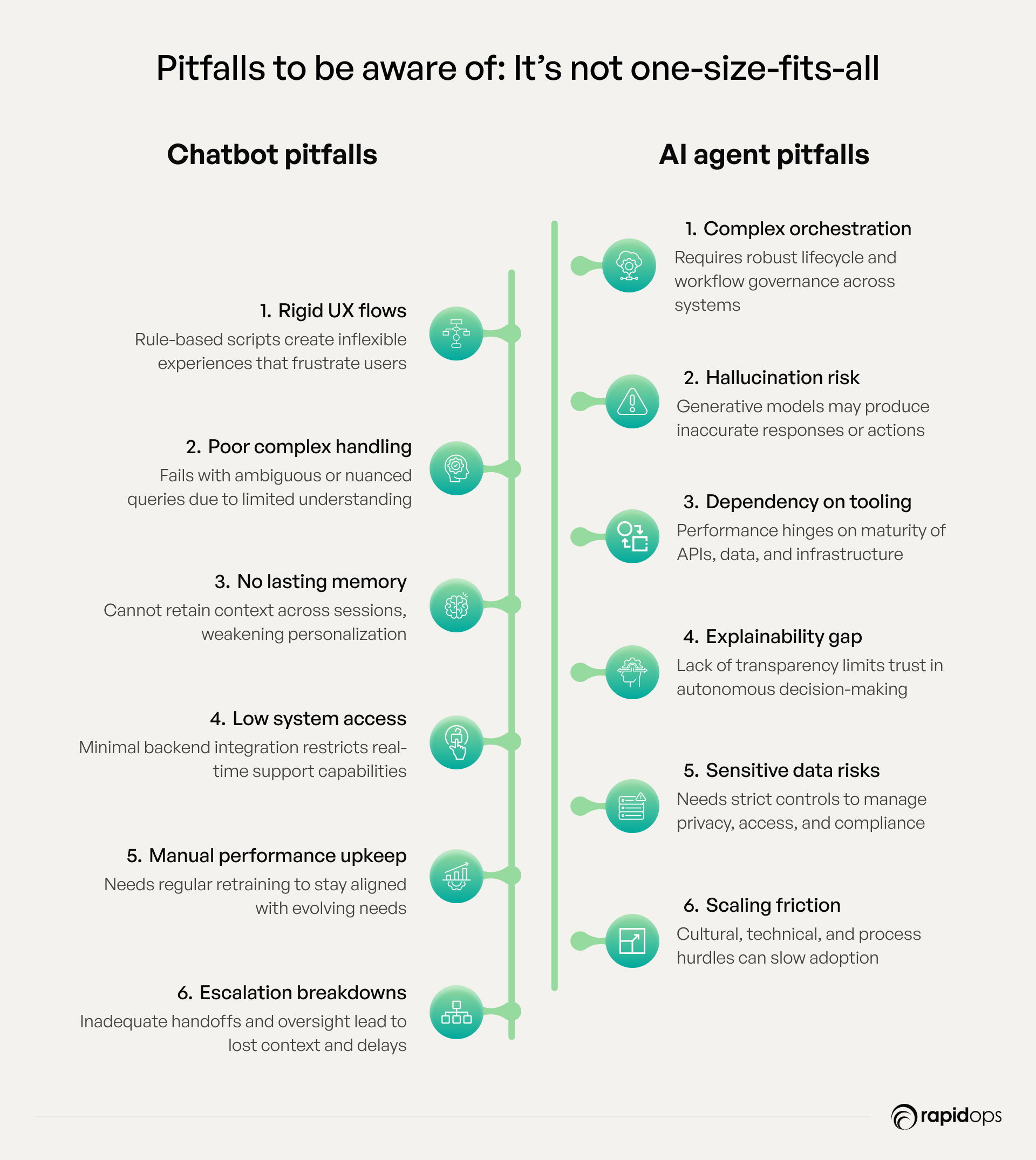
Chatbot pitfalls
Rigid UX and limited flexibility
Chatbots operate within predefined rules and narrowly structured conversational flows. This rigidity can frustrate customers when interactions deviate from expected patterns, reducing the effectiveness of support and impacting customer satisfaction.
Challenges with complex or ambiguous queries
Reliance on static rule sets and limited natural language understanding often prevents chatbots from resolving complex customer inquiries or multi-turn conversations. As a result, interactions may feel incomplete, and human agents may need to intervene.
Static performance without ongoing updates
Chatbots require manual retraining or updates to accommodate evolving customer inquiries, user inputs, or product changes. Without this, chatbots can become outdated, impacting responsiveness and operational reliability.
Limited context retention
Most chatbots are stateless, unable to leverage past interactions or maintain context-aware conversations. This limits their ability to provide personalized, seamless support across multiple channels.
Shallow integration with enterprise systems
Minimal connectivity with CRM, ERP, knowledge bases, and other external tools restricts chatbots to information retrieval rather than real-time task execution, constraining their overall utility.
Escalation gaps and oversight challenges
Inadequate escalation mechanisms or insufficient monitoring can lead to delays, errors, or fragmented handoffs to human agents, undermining the support experience.
Enterprises should weigh these constraints against desired customer support objectives to ensure chatbot deployments deliver meaningful value without compromising service quality.
AI agent pitfalls
While AI agents offer transformative potential in customer support, their deployment presents distinct challenges requiring careful planning.
Complex orchestration and lifecycle management
AI agents operate across multi-step workflows and integrate with multi-agent systems, requiring careful orchestration. Maintaining the ongoing maintenance of these systems demands robust governance and operational oversight to sustain reliability and efficiency.
Risk of hallucinations or incorrect actions
AI agents, particularly those powered by generative AI or large language models, may produce unintended responses or perform incorrect tasks. In customer support, such errors can compromise trust and necessitate rigorous validation mechanisms.
Dependency on tooling maturity
The effectiveness of AI agents relies on mature AI-powered systems, APIs, and external tools. Fragmented or underdeveloped ecosystems can reduce performance, delay task execution, and increase reliance on human intervention.
Explainability and trust challenges
To ensure confidence in AI agents, enterprises must implement transparent frameworks and validation processes that demonstrate predictable and accountable behavior. Without this, trust and adoption may suffer.
Data access, sensitivity, and compliance risks
AI agents require access to sensitive customer data, operational systems, and real-time data streams. Enterprises must enforce robust privacy, security, and compliance protocols to mitigate risk while enabling AI-driven automation.
Scalability and change management hurdles
Scaling AI agents across dynamic environments involves both technical and organizational challenges. Effective change management ensures adoption, minimizes disruption, and allows agents to evolve alongside customer needs and enterprise goals.
By proactively addressing these pitfalls, enterprises can unlock the full potential of AI agents while safeguarding service quality, compliance, and customer trust, turning automation into a strategic enabler rather than a liability.
Don't think of deploying AI agents without knowing these key factors that drive success & prevent costly mistakes
Download Now
Do you need a chatbot, an AI agent or both
Selecting the right solution for your enterprise depends on use case complexity, integration requirements, and desired business outcomes. Understanding the distinctions between AI agents vs chatbots, and their respective strengths, ensures investments drive operational efficiency, customer satisfaction, and scalable automation.
When a chatbot is the right fit
Chatbots excel in managing structured, high-volume interactions where speed, scalability, and reliability take priority over deep personalization. They are particularly effective when user interactions follow predictable flows, and the system does not need to interpret user intent beyond the immediate inputs.
Ideal for standardized, repetitive tasks
Chatbots are best suited for routine tasks, such as answering FAQs, checking order statuses, or scheduling appointments. Leveraging predefined rules, they deliver consistent responses with minimal human intervention, ensuring reliable service at scale.
Effective for single-turn, linear workflows
When user inputs are predictable and workflows are straightforward, chatbots provide fast automation without requiring complex reasoning or multi-step workflows. They are highly scalable and capable of handling thousands of customer inquiries simultaneously.
Fast deployment and minimal system integration
Template-based or low-code platforms allow enterprises to deploy chatbots quickly, reducing dependency on IT resources. They perform well in surface-level workflows and do not require deep integration with external tools, ERP, CRM, or real-time data systems.
Seamless escalation and support continuity
When queries exceed chatbot capabilities, intelligent fallback logic ensures smooth escalation to human agents, maintaining customer satisfaction and avoiding workflow disruption. For organizations seeking high-volume, low-complexity automation, chatbots remain a cost-effective entry point into digital support.
When an AI agent adds more value
AI agents become indispensable when customer support demands adaptive reasoning, context-aware interactions, and integration across enterprise systems. Designed for complex workflows and multi-step task execution, AI agents transform support operations into intelligent, high-impact experiences.
Handle complex, multi-step workflows
AI agents manage branching workflows and adapt dynamically to variations in user inputs, system states, or external events. They excel in scenarios such as multi-faceted billing issues, claims processing, or returns management, delivering accuracy and consistency where rule-based chatbots fall short.
Enterprise integration for end-to-end resolution
By connecting with CRM, ERP, inventory platforms, and other external tools, AI agents orchestrate customer data across channels to resolve issues without human intervention. They provide real-time updates and actionable insights, improving operational efficiency while reducing human efforts.
Context retention and personalized responses
AI agents leverage memory of past interactions and customer behavior to deliver tailored support. Through context-aware conversations, they anticipate needs, recognize recurring issues, and offer proactive solutions that enhance customer experience.
Intelligent tool-augmented reasoning
Agents integrate with APIs, databases, calculators, and even generative AI capabilities to perform complex tasks. They verify information, compute charges, interpret documents, and execute multi-agent collaboration, providing adaptive automation far beyond traditional chatbots.
Minimized human intervention and risk mitigation
Through autonomous task execution, AI agents reduce dependency on human agents for routine or complex tasks. They maintain audit trails, enforce compliance protocols, and operate within dynamic environments, ensuring reliable, scalable, and secure customer support operations.
When a hybrid pattern works best
For many enterprises, the optimal approach combines chatbots and AI agents, leveraging the simplicity of chatbots with the intelligence of agents behind the scenes. This hybrid architecture delivers personalized, scalable, and reliable support across multiple touchpoints.
Chatbots as front-end interface
Conversational chatbots provide a familiar UI, guiding users, collecting inputs, and maintaining brand tone and accessibility. They handle straightforward interactions while ensuring a smooth user experience.
AI agents powering backend automation
AI agents manage decision logic, enterprise system integration, and multi-step workflows, executing tasks such as data validation, order updates, and policy-based decisioning. Modular agents can collaborate, each performing specialized subtasks while maintaining real-time synchronization.
Unified orchestration and continuous context
A central orchestration layer coordinates between chatbots, agents, and systems, ensuring error-free task execution, context management, and seamless handoffs. Continuous memory across user sessions reduces friction, enhances trust, and improves overall customer satisfaction.
Enterprise-grade scalability with reduced UX complexity
The hybrid model balances intelligent automation with user simplicity, enabling enterprises to deliver high-quality support at scale without overwhelming users. By combining front-end usability with back-end AI agent execution, businesses achieve operational efficiency, context-aware support, and sustainable business growth.
By combining intuitive front-end design with intelligent agent-based execution, hybrid patterns enable enterprises to automate support journeys at scale without compromising personalization, context, or reliability.
Choosing the right one: A decision framework
As enterprises modernize customer support, choosing between chatbots, AI agents, or hybrid architectures requires a structured approach. The decision depends on workflow complexity, system integration needs, user interactions, and the desired level of customer experience. This framework helps organizations make informed choices, ensuring scalable, intelligent support outcomes while optimizing operational efficiency.
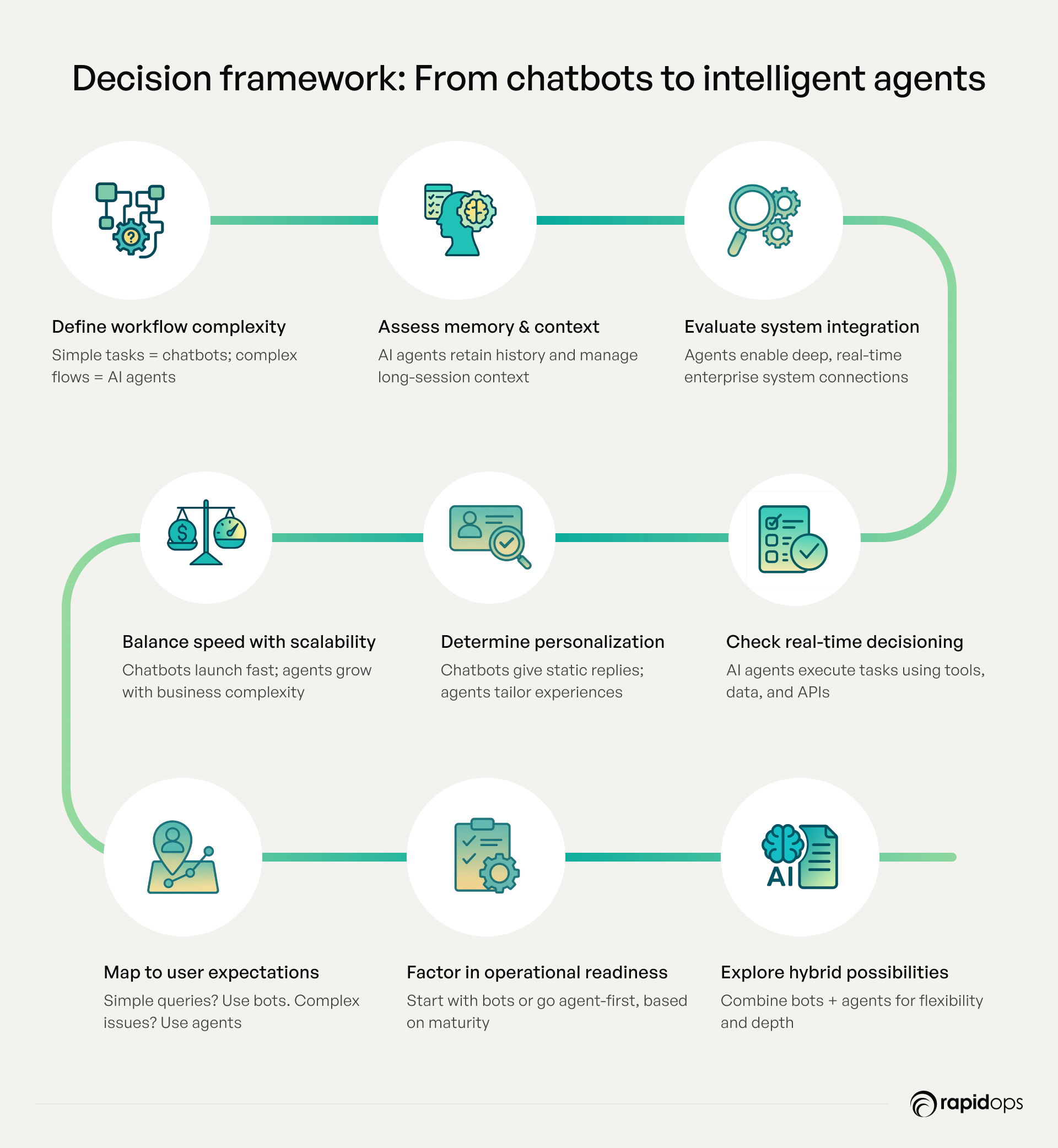
1. Define workflow complexity
Start by analyzing end-to-end support workflows. Are the tasks simple, linear, and rule-based, or do they involve multistep workflows, branching logic, and dynamic decision-making? Chatbots excel at automating routine tasks and predefined rules, while AI agents are designed to handle complex tasks and orchestrate multi-agent systems across dynamic environments.
2. Assess memory and contextual Needs
Evaluate whether interactions require persistent memory, historical reference, or context-aware conversations across multiple channels. AI agents integrate memory of past interactions and maintain context windows to deliver human-like conversation, reducing repetitive queries and enhancing customer satisfaction. Chatbots, by contrast, are suited for single-turn, structured interactions.
3. Evaluate system integration depth
Determine the level of integration required with CRM, ERP, billing, knowledge, or inventory systems. AI agents excel at orchestrating ai powered systems and leveraging external tools for real-time execution, whereas chatbots typically perform surface-level operations with minimal backend integration. Proper integration ensures accurate real-time data analysis and reduces human intervention in routine workflows.
4. Check for real-time data and tool-augmented execution
For tasks requiring autonomous decision making or tool-assisted workflows like refund eligibility checks, product substitution, or delivery re-routing AI agents can perform complex tasks using generative AI tools and APIs. Unlike chatbots, agents can handle unstructured data, retrieve live data from multiple sources, and apply advanced algorithms for precision-driven outcomes.
5. Determine personalization scope
Support personalization depends on user profiles, behavioral patterns, or prior customer interactions. AI agents enable adaptive responses grounded in user intent, customer data, and past interactions, elevating experiences from transactional to strategic. Chatbots, operating on predefined rules, are limited to uniform responses.
6. Balance time-to-value with scalability
Chatbots provide rapid deployment and cost-efficient coverage for high-volume, repetitive queries. However, enterprises aiming for long-term scalability, complex logic, or multi-channel orchestration benefit from AI agents or hybrid solutions, which maximize operational efficiency while supporting evolving business needs.
7. Map to user expectations
Align solution complexity with customer expectations. Users seeking routine updates or standardized responses are well-served by chatbots. High-stakes inquiries or multi-step workflows demand AI agents capable of context-aware conversations, large language model reasoning, and adaptive decision-making.
8. Factor in organizational readiness
Assess internal capabilities for designing, training, and maintaining AI agents. Teams with mature machine learning and AI technology advances expertise can leverage agent-driven automation. Organizations less experienced may start with chatbot foundations and evolve to hybrid architectures as human efforts are supplemented by ai driven automation.
9. Explore hybrid possibilities
Hybrid architectures combine the user-friendly interface of chatbots with the backend intelligence of AI agents. Chatbots handle initial user inputs and guide interactions, while AI agents execute multi-step workflows, integrate with enterprise systems, and maintain session continuity. Modular ai agents offer task-specific operations one may fetch order data, another validate credentials, and a third update customer data all coordinated via a unified orchestration layer.
By applying this framework, enterprises can select the architecture that optimally balances speed, intelligence, and customer experience, while leveraging ai powered systems, minimizing human intervention, and scaling support operations in line with evolving expectations.
The result is a support ecosystem that is context-aware, adaptive, and capable of performing complex tasks, positioning organizations for business growth and long-term operational excellence.
From superficial similarities to strategic decisions
When customers expect speed, accuracy, and thoughtful responses, choosing the right automation strategy becomes more than a technical choice, it’s a defining moment in how your enterprise shows up for its customers. The right combination of chatbots, AI agents, or hybrid models can turn routine interactions into meaningful, trust-building engagements.
Chatbots manage repetitive inquiries efficiently, freeing teams to focus on higher-value work, while AI agents are continuously designed, implemented, and optimized to manage complex workflows, adapt to real-time context, and integrate seamlessly with enterprise systems, enabling support that feels intelligent, personalized, and effortless.
At Rapidops, our AI specialists help forward-thinking enterprises bridge this gap between technology and outcomes. With over 16 years of experience delivering AI-powered, data-driven platforms, we design, implement, and optimize AI agents that integrate deeply with enterprise data, tools, and teams. This experience ensures measurable impact—faster resolutions, enriched customer satisfaction, and operational efficiency that fuels sustainable business growth.
Ready to explore what’s possible?
Schedule a complimentary session with an AI expert to evaluate your systems and workflows, uncover where chatbots and AI agents can deliver the greatest value, and receive practical guidance grounded in clarity, precision, and measurable results.
Frequently Asked Questions
What makes AI agents more effective than chatbots in customer support?
AI agents outperform traditional chatbots by combining context-aware reasoning, autonomous decision-making, and multi-step workflow orchestration. Unlike chatbots that rely on predefined rules and static responses, AI agents integrate with ERP, CRM, and real-time data streams, interpret complex user intent, and dynamically adapt responses across multi-channel interactions. This enables enterprises to resolve complex inquiries faster, reduce human intervention, optimize operational efficiency, and improve customer satisfaction at scale. Their ability to learn from past interactions and continuously improve ensures sustained value over time.
How do AI agents personalize customer interactions in real time?
AI agents leverage natural language understanding (NLU), machine learning models, and historical interaction data to create context-aware, dynamic responses. They consider past behavior, product usage, account preferences, and current system state to provide tailored recommendations, proactive notifications, or next-best actions. This personalization ensures that interactions are not only relevant but also enhance the customer experience, reduce friction, and build trust, transforming routine support into strategic engagement.
Can AI agents understand and resolve complex support queries without human handoff?
Yes. AI agents are built for autonomous decision-making and can handle multi-step, multi-turn workflows without human intervention. By analyzing structured and unstructured data, user intent, and real-time system states, agents can resolve issues like billing discrepancies, technical troubleshooting, or order management. Only in exceptional cases, where ambiguity exceeds defined thresholds—do they escalate to human agents. This hybrid efficiency reduces response times, improves resolution rates, and maintains high-quality customer experience.
How do AI agents manage context when a customer switches channels mid-conversation?
AI agents maintain a persistent memory and unified context across channels, enabling seamless handoffs between chat, email, voice, and social media. They track conversation history, session context, and user preferences, ensuring continuity without repetition. By leveraging context windows and session-aware memory, AI agents deliver coherent responses, improve omnichannel support consistency, and reduce customer frustration, giving enterprises a competitive edge in customer experience management.
Can AI agents initiate proactive support based on user behavior or product usage?
Absolutely. AI agents continuously analyze real-time customer behavior, system events, and historical trends to identify potential issues before they arise. For example, they can preempt failed transactions, suggest upgrades, or notify customers of service impacts. This proactive support increases engagement, trust, and retention, while also lowering support volume and operational costs, creating measurable value for enterprises.
How do AI agents collaborate with human agents in a blended support model?
In a hybrid model, AI agents handle routine, repetitive, or data-intensive tasks, such as answering FAQs, retrieving account information, or updating CRM records, allowing human agents to focus on strategic, complex, or sensitive interactions. They provide real-time suggestions, predictive insights, and workflow automation, enhancing agent productivity and consistency. This collaboration creates a synergistic support model, balancing efficiency, expertise, and personalized customer engagement.
How quickly can an enterprise deploy and train AI agents for customer service?
Deployment depends on workflow complexity, system integrations, and data readiness. Using pre-built AI frameworks, low-code platforms, and ML-powered training pipelines, enterprises can implement AI agents within weeks, not months. Ongoing optimization is supported by continuous learning from live interactions, feedback loops, and model retraining, ensuring agents remain adaptive, accurate, and aligned with evolving customer needs. This enables rapid ROI, faster operational efficiency, and measurable improvement in customer satisfaction.
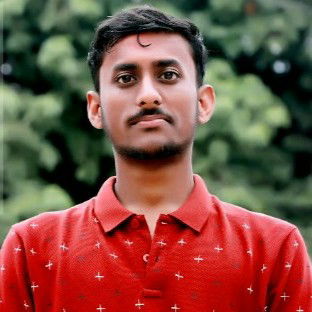
Rahul Chaudhary
Content Writer
With 5 years of experience in AI, software, and digital transformation, I’m passionate about making complex concepts easy to understand and apply. I create content that speaks to business leaders, offering practical, data-driven solutions that help you tackle real challenges and make informed decisions that drive growth.
What’s Inside
- Why chatbots and AI agents are often confused
- What chatbots are, how they work, and the types that exist
- What AI agents are, how they work, and the types that exist
- AI agent vs chatbot: Key differences that matter
- How chatbots and AI agents drive value for your enterprise
- Pitfalls to be aware of: It’s not one-size-fits-all
- Do you need a chatbot, an AI agent or both
- Choosing the right one: A decision framework
- From superficial similarities to strategic decisions

Let’s build the next big thing!
Share your ideas and vision with us to explore your digital opportunities
Similar Stories
- AI
- 4 Mins
- September 2022

- AI
- 9 Mins
- January 2023


Receive articles like this in your mailbox
Sign up to get weekly insights & inspiration in your inbox.

